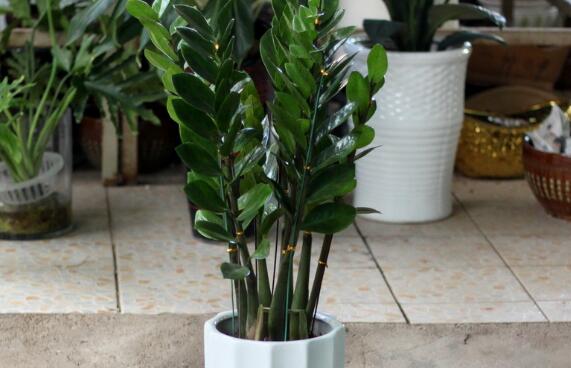How to prevent and cure root-knot nematode disease of four seasons begonia?
The pathogenic nematode of root-knot nematode disease of Begonia can harm the lateral root and small root of the plant, stimulate the root tissue to form giant cells and make the cells divide and proliferate excessively, resulting in many tumors ranging in diameter from 1mm to 10mm. The tumor is smooth in the initial stage, rough in the later stage, and often grows with many whisker roots, which can grow alone or can be connected into strings. Pear-shaped transparent white spots can be seen in the fresh gall tumor, that is, the female nematode. Due to the hindrance of root growth, affecting the absorption of water and fertilizer nutrition, plant dwarfing, leaves becoming smaller, yellow wilt, Internode shortening, and finally withered.
The root-knot nematode disease of Begonia is caused by the infection of southern root-knot nematodes of nematodes. The pathogenic nematode is male and female. The female adult is pear-shaped, visible to the naked eye, 0.4-1.4 mm long and 0.3-0.8 mm wide. The four seasons begonia root-knot nematode overwinters as egg and egg larvae or males in the residual roots and soil of diseased plants. When the soil temperature rises to more than 10 ℃ in the next year, the eggs hatch into larvae and infect the tender roots. Nematodes do not have a wide range of activities, and generally spread by means of irrigation water, surface runoff, seedling transplanting, human activities and so on. The soil temperature of 22-30 ℃ is the peak of nematode infection, and a large number of tumors are formed. The most suitable soil temperature for growth and development is 2530 ℃, and the soil water content is about 40%. When the larvae are below 10 ℃, they cease to be active. At 35 ℃, he died 5 minutes later.
Control methods: when raising seedlings with ① cuttings or planting in pots, disease-free soil must be selected to avoid collecting soil in previous areas where nematodes are infected. In hot summer weather, the soil can be exposed to the sun to kill nematodes. ② disinfects the soil with chemicals. Dig holes or ring trenches in the basin soil, then apply 5 ml of dichlorvos solution in each basin, immediately flatten the soil, fumigate for half a month, or use 300 times of 80% dibromochloropropane 200 ml in each basin, as before. ③ diseased plants can be treated with 10% gram of monophosphate granules, 1 to 2 grams per plant, once every 30 days, twice in a row.
Control methods of root-knot nematode disease of begonia
Four Seasons Begonia damaged by root-knot nematode. The whole plant is weak and short. The leaves wilted and died in severe cases. Nodules of different sizes are formed on the roots (lateral roots, fibrous roots).
The shape is milky white to yellowish white, wrapped in a brown film. The surface is rough. Nodules are the proliferators formed by parasitic root-knot nematodes.
The pathogen is root knot nematode [Meloidogyne imcognita (Kofoid et White) chitwood]. The insect lives as eggs and larvae on the remains of host plants in the soil. The soil temperature is above 20 ℃ and the humidity is 40%. Most females enter into human host tissues before sexual maturity and can carry out parthenogenesis to stimulate plant tissues to form tumors, which seriously hinders the physiological function of plants. The nematode can occur all the year round in greenhouse, and it is the most serious in May and June.
Control methods of Rhizosphere nematode Disease of Malus sijiensis
Four seasons begonia rhizosphere nematode disease: it mainly harms the root system, causing the root to grow yellow and white nodules, shortening the plant internodes, shrinking leaves, and seriously withering.
Prevention and treatment: the basin soil should be disinfected before it can be used.
- Prev

How to prevent stem rot and white silk disease of money tree?
How to raise money trees? Send you a book "flower trick 868 moves", from now on no longer worry about raising bad money tree! How to get this book
- Next

Why do the leaves of jasmine turn yellow easily?
The leaves of jasmine are thinner and more sensitive than ordinary flowers, and the leaves are yellow or even scorched in potted plants, which indicates that the normal growth of the plant has been affected and the root system has been partially necrotic. There may be many reasons, but the following are the following: (1) if the plant has been growing normally
Related
- Fuxing push coffee new agricultural production and marketing class: lack of small-scale processing plants
- Jujube rice field leisure farm deep ploughing Yilan for five years to create a space for organic food and play
- Nongyu Farm-A trial of organic papaya for brave women with advanced technology
- Four points for attention in the prevention and control of diseases and insect pests of edible fungi
- How to add nutrient solution to Edible Fungi
- Is there any good way to control edible fungus mites?
- Open Inoculation Technology of Edible Fungi
- Is there any clever way to use fertilizer for edible fungus in winter?
- What agents are used to kill the pathogens of edible fungi in the mushroom shed?
- Rapid drying of Edible Fungi

